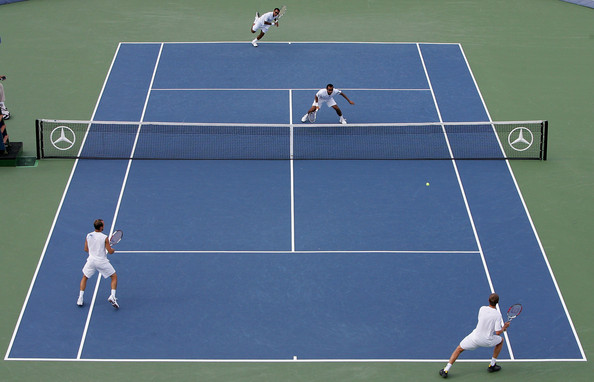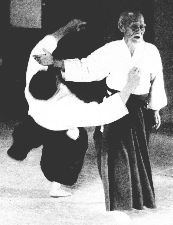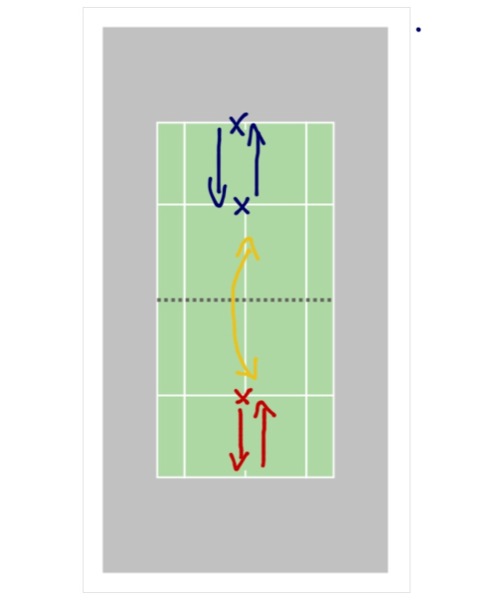Keep Things Simple For Doubles Success
 Tuesday, June 19, 2012 at 01:17AM
Tuesday, June 19, 2012 at 01:17AM  CAtennis
CAtennis  Not only is playing doubles fun but it is also a great way to ensure that your singles game will improve. However, the improvement will be limited if you and your partner keep exiting the draw sooner than you should. Because of the dimensions and characteristics of the game, doubles require a different approach than singles. It is not so much about beauty or protracted tactics but about aggressivess and subtle strategy. Think: percentages.
Not only is playing doubles fun but it is also a great way to ensure that your singles game will improve. However, the improvement will be limited if you and your partner keep exiting the draw sooner than you should. Because of the dimensions and characteristics of the game, doubles require a different approach than singles. It is not so much about beauty or protracted tactics but about aggressivess and subtle strategy. Think: percentages.
Here are some tips to help you and your partner win more matches (remember: the more doubles matches you win, the better of a player - doubles AND singles - you will become):
1. OUTSIDE/OUTSIDE; INSIDE/INSIDE ("OO-II"): This generally means that the net player should cover the spot that is hit by his partner. For example, if the partner hits the ball towards the outside of the court (e.g., into the doubles alley), the netman should cover the line. If the partner hits the ball into the center of the court, the netman should move to cover more of the middle. OO-II will reduce the possibility that the opponent will hit the ball "BY" you. In other words, by covering the line (outside) or center (inside), the opponent will be forced to hit a shot that crosses in front of the netman - giving him the opportunity to pick away some volleys. If the netman's partner hits the ball "outside" and the netman covers the middle (inside), the opponent has a clear target down the line where he could hit the passing shot. In the same vein, limit the number of times you cross on your partner's out-wide serve. If, on the deuce side, your partner slices the serve out wide and the netman crosses, the returner will be able to burn a down the line return without an obstacle in the way. If the netman holds his ground on the outwide serve, the returner will be forced to take that serve in the middle of the court - hard to do with a netman in the way who is ready to cherry-pick any timid replies.
2. THUMP-HIGH; STICK-NET; DROP-LOW: Inexperienced players tend to overcomplicate the volleys. Sometimes, I see players trying to drop-volley balls on top of the net or hammer balls below the net. Then these players get frustrated when their shot selection doesn't pan out. The great doubles players keep things extremely simple. The pace of the game is too quick to experiment with elaborate plays. So, when faced with a volley, remember the following: A) Balls that are "on top" of the net (2 feet or more) should be hammered down - preferably at an angle. Try to drop volley these, and the gravity will make the ball bounce high thereby enabling the opponents to get to the ball. Take away this possibility and just thump the ball out of your opponents' reach; B) Stick deep volleys that are net level (net level - approx. 2 feet). Balls that are net-height are more difficult to be angled away or drop-volleyed. Therefore, stick them deep and look for the opportunity on the next shot. Treat these balls as set-up shots. C) Drop-volley balls that are below the net. If you're close to the net and the opponent's shot has dipped below the net, try to drop volley the ball. A good drop volley will cause the opponent to pop up a response which you and your partner should put away. If you're farther away from the net, stick these volleys deep and transition your way to the net, however, from close up, the angle over the net is far too steep to do anything but try to drop volley the shot.
3. GIVE YOURSELF A LIMIT: Too many times, players tend to rally cross-court from the baseline without rhyme or reason. Doubles is about percentages. The first team to get to the net usually wins the point. Therefore, if you're a singles player who uses the same strategy (consistency) in doubles force yourself to become more aggressive; take some chances. Tell yourself (and your partner) that on the 3rd (or 4th, or 5th...) shot you're coming in "come hell or high water". This mentality will assist you in becoming a more proactive doubles player. If you KNOW that you have to be in on the 4th shot, your 1st, 2nd and 3rd shots will be more and more aggressive. In other words, instead of passively waiting for something to happen, you will start making things happen. In the beginning, you will struggle with this mentality...it's something new. You certainly wouldn't come in off some of these shots in singles. However, the psychological implications of doubles (quciker pace; your partner assisting you) as well as the court characteristics make it very attractive to come in even on balls that would be considered high-risk in singles. Once you become proficient at coming in off a variety of balls, covering the ground and making shoelace level pick-ups, your singles game will improve along with your doubles game.
4. KEEP THE NET-PERSON HONEST: Once a game (at least), you and your partner should decide to take a return down the line towards the net person. Before the game starts, talk to your partner and decide which one of you will - even if the opening isn't really there - take the return right towards the net-persons head. Sow the seeds of doubt by making the net person volley even if she's not looking to volley on that particular play. Keep her honest and send the message that you're not afraid to go down the line. By picking a target in advance, you will hit a much more solid return than you would had you tried to change direction after the net-person signals that she's moving. Chances are that a good down the line return will cause the net player to miss eliciting "I'm sorry" or "my bad" apologies. Do this enough times, and it's likely that the player will retreat to her shell not wanting to touch any more volleys out of fear of letting down her partner. This is exactly what you want: one player (preferably both) to completely disengage from the game. When your opponents are split by doubt and communication breaks down, your chances of success in doubles will improve dramatically.


